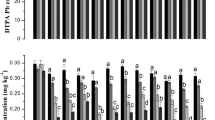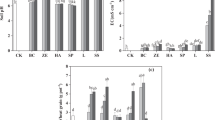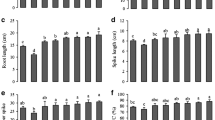Abstract
Purpose
Rapid industrialization in China accelerated environmental pollution by xenophores and trace metals particularly cadmium. Numerous studies have been conducted to address soil contamination using organic and inorganic amendments under pot or incubation conditions, but few were performed under field conditions, particularly in the wheat-growing areas. This study aims to investigate the effectiveness of pre-applied soil amendments for Cd immobilization, changes in soil pH, and metal uptake by wheat.
Materials and methods
In this study, 12 treatments, i.e., control (CK), lime, DaSan Yuan (DASY), DiKang No. 1 (DEK1), biochar, Fe-biochar, Yirang, CaMgP, and green stabilizing agents (GSA-1, GSA-2, GSA-3, and GSA-4), were evaluated for Cd immobilization in incubation and field experiments. Changes in soil pH and available metal content with amendments were monitored from 30 to 150 days of incubation. Single extraction method and DTPA-extractable and sequential extraction procedures were employed to assess the variations in available Cd contents of field soil. The impact of soil amendments on Cd uptake and bioaccumulation in food part of wheat was measured at harvesting stage in a contaminated site.
Results and discussion
Lime treatment increased soil pH by 32% and reduced available Cd to 0.213 mg kg−1, as compared to CK (control) in the incubation experiment (0.343 mg kg−1). Effects of the amendments on wheat growth, soil pH, and Cd phytoavailability were reported. Wheat biomass was highest in treatment GSA-2 (13,880 kg ha−1) and GAS-4 resulted in an increase in grain yield (5350 kg ha−1). Soil pH of the treated field at harvesting stage increased up to 6.50, 6.50, and 6.47 by application of GSA-4, GSA-2, and lime, respectively. Cadmium contents in wheat grain were declined significantly in the treatments of GSA-2, GSA-4, and lime.
Conclusions
Results of this study revealed a significant decrease in available Cd concentration with the application of amendments. Composite amendments were more effective in terms of metal uptake and bioaccumulation in wheat. In addition, our results indicate the effectiveness of composite amendments in stabilizing Cd in contaminated soil.





Similar content being viewed by others

References
Abad-Vale P, Álvarez-Ayuso E, Murciego A, Pellitero E (2016) Assessment of the use of sepiolite amendment to restore heavy metal polluted mine soil. Geoderma 280:57–66
Alkorta I, Becerril JM, Garbisu C (2010) Phytostabilization of metal contaminated soils. Rev Environ Health 25:135
Antoniadis V, Alloway BJ (2002) The role of dissolved organic carbon in the mobility of Cd, Ni and Zn in sewage sludge-amended soils. Environ Pollut 117:515–521
Bao SD (2008) Soil agricultural chemistry analysis method, Third edition. China Agriculture Press, Beijing in Chinese
Bauddh K, Singh RP (2012) Growth, tolerance efficiency and phytoremediation potential of Ricinus communis (L.) and Brassica juncea (L.) in salinity and drought affected cadmium contaminated soil. Ecotoxicol Environ Saf 85:13–22
Bolan NS, Makino T, Kunhikrishnan A, Kim PJ, Ishikawa S, Murakami M (2013) Chapter four—cadmium contamination and its risk management in rice ecosystems. Adv Agron 119:183–273
Burton CH, Turner C (2003) Manure management: treatment strategies for sustainable agriculture. Editions Quae, pp 451
Cao XD, Wahbi A, Ma L, Li B, Yang Y (2009) Immobilization of Zn, Cu, and Pb in contaminated soil using phosphate and phosphoric acid. J Hazard Mater 164:555–564
Chen SB, Xu MG, Ma YB, Yang JC (2007) Evaluation of different phosphate amendments on availability of metals in contaminated soil. Ecotoxicol Environ Saf 67:278–285
Granda M, Pe ´r AI, ME D’a (2006) Zeolites and zeolite-based materials in analytical chemistry. TrAC Trends Anal Chem 25:24–30
Guo X, Wei Z, Penn C, Xu T, Wu Q (2013) Effect of soil washing and liming on bioavailability of heavy metals in acid contaminated soil. Soil Sci Soc Am J 77:432–441
Guo F, Ding C, Zhou Z, Huang G, Wang X (2018) Effects of combined amendments on crop yield and cadmium uptake in two cadmium contaminated soils under rice-wheat rotation. Ecotoxicol Environ Saf 148:303–310
Hamid Y, Tang L, Xiao ZW, Hussain B, Yaseen M, Aziz MA, Yang X (2018) Immobilization of cadmium and lead in contaminated paddy field using inorganic and organic additives. Sci Rep 8:17839
Hamid Y, Tang L, Yaseen M, Hussain B, Zehra A, Aziz MA, He ZL, Yang X (2019a) Comparative efficacy of organic and inorganic amendments for cadmium and lead immobilization in contaminated soil under rice-wheat cropping system. Chemosphere 214:259–268
Hamid Y, Tang L, Muhammad IS, Xuerui C, Hussain B, Aziz MA, Muhammad U, He ZL, Yang X (2019b) An explanation of soil amendments to reduce cadmium phytoavailability and transfer to food chain. Sci Total Environ 660:80–96
Han D, Luo D, Chen Y, Wang G (2013) Transfer of Cd, Pb, and Zn to water spinach from a polluted soil amended with lime and organic materials. J Soils Sediments 13:1360–1368
Harmsen J, Naidu R (2013) Bioavailability as a tool in site management. J Hazard Mater 261:840–846
He YB, Huang DY, Zhu QH, Wang S, Liu SL, He HB, Zhu HH, Xu C (2017) A three-season field study on the in-situ remediation of Cd-contaminated paddy soil using lime, two industrial by-products, and a low-Cd accumulation rice cultivar. Ecotoxicol Environ Saf 136:135–141
Herath I, Kumarathilaka P, Navaratne A, Rajakaruna N, Vithanage M (2015) Immobilization and phytotoxicity reduction of heavy metals in serpentine soil using biochar. J Soils Sediments 15:126–138
Houben D, Pircar J, Sonnet P (2012) Heavy metal immobilization by cost-effective amendments in a contaminated soil: effects on metal leaching and phytoavailability. J Geochem Explor 123:87–94
Hu J, Wu F, Wu S (2014) Biochar and Glomus caledonium influence Cd accumulation of upland kangkong (Ipomoea aquatica Forsk.) intercropped with Alfred stonecrop (Sedum alfredii Hance). Sci Rep 4:4671
Jung E, Ahmad M, Lee SS, Shope CL, Hashimoto Y, Kwon-Rae K, Usman ARA, Yang JE, Ok YS (2013) Effects of lime-based waste materials on immobilization and phytoavailability of cadmium and lead in contaminated soil. Clean – Soil Air Water 41:1235–1241
Khan A, Khan S, Khan MA, Qamar Z, Waqas M (2015) The uptake and bioaccumulation of heavy metals by food plants, their effects on plants nutrients, and associated health risk: a review. Environ Sci Pollut Res 22:13772–13799
Kragovic M, Dakovic A, Sekulic Z, Trgo M, Ugrina M, Peric J, Gatta GD (2012) Removal of lead from aqueous solutions by using the natural and Fe(III)-modified zeolite. Appl Surf Sci 258:3667–3673
Lee SS, Lim JE, El-Azeem S, Choi B, Oh S, Moon DH, Ok YS (2013) Heavy metal immobilization in soil near abandoned mines using eggshell waste and rapeseed residue. Environ Sci Pollut Res 20:1719–1726
Li HS (2000) Principle and technology of plant physiological and biochemical experiment. Higher Education Press, Beijing (in Chinese)
Li P, Wang X, Zhang T, Zhou D, He Y (2008) Effects of several amendments on rice growth and uptake of copper and cadmium from a contaminated soil. J Environ Sci-China 20:449–455
Li H, Shi WY, Shao HB, Shao MA (2009) The remediation of the lead-polluted garden soil by natural zeolite. J Hazard Mater 169:1106–1111
Li Z, Liao W, Zhong Z (2015) Co-remediation of lead, cadmium and zinc contaminated soil using exogenous hydroxyapatite, zeolite, limestone and humic acid. Fresenius Environ Bull 24:1425–1433
Li LF, Ai SY, Wang YH, Tang MD, Li YC (2016) In situ field-scale remediation of low Cd-contaminated paddy soil using soil amendments. Water Air Soil Pollut 227–342
Liang XF, Han J, Xu YM, Sun YB, Wang L, Tan X (2014) In situ field-scale remediation of Cd polluted paddy soil using sepiolite and palygorskite. Geoderma 235-236:9–18
Liang X, Yi X, Yingming X, Pengchao W, Lin W, Yuebing S, Qingqing H, Rong H (2016) Two-year stability of immobilization effect of sepiolite on Cd contaminants in paddy soil. Environ Sci Pollut Res 23:12922–12931
Lim JE, Lee SS, Ok YS (2015) Efficiency of poultry manure biochar for stabilization of metals in contaminated soil. J Appl Biol Chem 58:39–50
Ma L, Xu R, Jiang J (2010) Adsorption and desorption of Cu (II) and Pb (II) in paddy soils cultivated for various years in the subtropical China. Environ Sci 22:689–695
Méndez A, Terradillos M, Gascó G (2013) Physicochemical and agronomic properties of biochar from sewage sludge pyrolysed at different temperatures. J Anal Appl Pyrolysis 102:124–130
Meng F, Yuan G, Wei J, Bi D, Ok YS, Wang H (2017) Humic substances as a washing agent for Cd-contaminated soils. Chemosphere 181:461–467
Mkhabela M, Warman PR (2005) The influence of municipal solid waste compost on yield, soil phosphorus availability and uptake by two vegetable crops, grown in a Pugwash sandy loam soil in Nova Scotia. Agric Ecosyst Environ 106:57–67
Naeem A, Ghafoor A, Farooq M (2015) Suppression of cadmium concentration in wheat grains by silicon is related to its application rate and cadmium accumulating abilities of cultivars. J Sci Food Agric 95:2467–2472
Narupot P, Maleeya K, Prayad P, Ratanawat C (2010) Immobilization of cadmium in soil by cow manure and silicate fertilizer, and reduced accumulation of cadmium in sweet basil (Ocimum basilicum). Sci Asia 36:349–354
Oldare M, Arthurson V, Pell M, Svensson K, Nehrenheim E, Abubakar J (2011) Land application of organic waste—effects on the soil ecosystem. Appl Energy 88:2210–2218
Park JH, Lamb D, Paneerselvam P, Choppala G, Bolan N, Chung JW (2011) Role of organic amendments on enhanced bioremediation of heavy metal(loid) contaminated soils. J Hazard Mater 185:549–574
Petruzzelli G (2012) Soil contamination and remediation strategies. Current research and future challenge. EGU General Assembly Conference Abstracts 14:7963
Puga AP, Abreu CA, Melo LCA, Beesley L (2015) Biochar application to a contaminated soil reduces the availability and plant uptake of zinc, lead and cadmium. J Environ Manag 159:86–93
Rehman MZ, Rizwan M, Ghafoor A, Naeem A, Ali S, Sabir M, Qayyum MF (2015) Effects of inorganic amendments for in situ stabilization of cadmium contaminated soils and its phyto-availability to wheat and rice under rotation. Environ Sci Pollut Res 22:16897–16906
Sun Y, Guohong S, Yingming X, Weitao L, Xuefeng L, Lin W (2016) Evaluation of the effectiveness of sepiolite, bentonite, and phosphate amendments on the stabilization remediation of cadmium contaminated soils. J Environ Manag 166:204–210
Tang X, Li X, Liu X, Hashmi MZ, Xu J, Brookes PC (2015) Effects of inorganic and organic amendments on the uptake of lead and trace elements by Brassica chinensis grown in an acidic red soil. Chemosphere 119:177–183
Tang L, Luo WJ, Tian SK, He ZL, Stoffella PJ, Yang XE (2016) Genotypic differences in cadmium and nitrate co-accumulation among the Chinese cabbage genotypes under field conditions. Sci Hortic 201:92–100
Tessier A, Campbell PGC, Bisson M (1979) Sequential extraction procedure for the speciation of particulate trace metals. Anal Chem 51(7):844–851
Uchimiya M, Lima IM, Klasson KT, Wartelle LH (2010) Contaminant immobilization and nutrient release by biochar soil amendment: roles of natural organic matter. Chemosphere 80:935–940
Udeigwe TK, Wang JJ, Zhang H (2009) Effectiveness of bauxite residues in immobilizing contaminants in manure-amended soils. Soil Sci 174:676–687
Wang Y, Fang Z-Q, Liang B, Tsang E-P (2014) Remediation of hexavalent chromium contaminated soil by stabilized nanoscale zero-valent iron prepared from steel pickling waste liquor. Chem Eng J 247:283–290
Warren J, Phillips S, Mullins G, Zelazny L (2006) Impact of alum-treated poultry litter applications on fescue production and soil phosphorus fractions. Soil Sci Soc Am J 70:1957–1966
Woldetsadik D, Pay D, Bernard K, Bernd M, Fisseha I, Heluf G (2016) Effects of biochar and alkaline amendments on cadmium immobilization, selected nutrient and cadmium concentrations of lettuce (Lactuca sativa) in two contrasting soils. Springer Plus 5:397. https://doi.org/10.1186/s40064-016-2019-6
Wu W-H, Xie Z-M, Xu J-M, Wang F, Shi J-C, Zhou R-B, Jin Z-F (2013) Immobilization of trace metals by phosphate in contaminated soil near lead/zinc mine tailings evaluated by sequential extraction and TCLP. J Soils Sediments 13:1386–1395
Wu YJ, Zhou H, Zou ZJ, Zhu W, Yang WT, Peng PQ, Zeng M, Liao BH (2016) A three-year in-situ study on the persistence of a combined amendment (limestone sepiolite) for remedying paddy soil polluted with heavy metals. Ecotoxicol Environ Saf 130:163–170
Xi JF, Yu XZ, Zhou LX, Li DC, Zhang GL (2011) Comparison of soil heavy metal pollution in suburb fields of different regions. Soils 43:769–775
Yang Y, Nan Z, Zhao Z, Wang Z, Wang S, Wang X, Jin W, Zhao C (2011) Bioaccumulation and translocation of cadmium in cole (Brassica campestris L.) and celery (Apium graveolens) grown in the polluted oasis soil, Northwest of China. J Environ Sci 23:1368–1374
Yang WT, Hang Z, Jiao-Feng G, Bo-Han L, Pei-Qin P, Zeng Q-R (2017) Effects of a combined amendment on Pb, Cd, and As availability and accumulation in rice planted in contaminated paddy soil. Soil Sediment Contam 26:70–83
Yaseen M, Muhammad ZA, Asif M, Muhammad N, Yasir H, Sobia N, Muhammad AK (2017) Promoting growth, yield, and phosphorus-use efficiency of crops in maize–wheat cropping system by using polymer-coated ammonium phosphate. Commun Soil Sci Plant Anal 48:646–655
Zeng WA, Li F, Zhou H, Qin XL, Zou ZJ, Tian T, Zeng M, Liao BH (2016) Effect of calcium carbonate on cadmium and nutrients uptake in tobacco (Nicotiana tabacum L.) planted on contaminated soil. J Environ Biol 37:163–168
Zhou H, Zhou X, Zeng M, Liao BH, Liu L, Yang WT, Wu YM, Qiu QY, Wang YJ (2014) Effects of combined amendments on heavy metal accumulation in rice (Oryza sativa L.) planted on contaminated paddy soil. Ecotoxicol Environ Saf 101:226–232
Funding
This study was financially supported by the Key Projects from Ministry of Science and Technology of China (no. 2016YFD0800805), Zhejiang Provincial Science and Technology Bureau (nos. 2015C02011-3 and 2015C03020-2), and the Fundamental Research Funds for the Central University.
Author information
Authors and Affiliations
Corresponding author
Ethics declarations
Conflict of interest
The authors declare that they have no conflict of interest.
Additional information
Responsible editor: Fabio Scarciglia
Publisher’s note
Springer Nature remains neutral with regard to jurisdictional claims in published maps and institutional affiliations.
Rights and permissions
About this article
Cite this article
Hamid, Y., Tang, L., Lu, M. et al. Assessing the immobilization efficiency of organic and inorganic amendments for cadmium phytoavailability to wheat. J Soils Sediments 19, 3708–3717 (2019). https://doi.org/10.1007/s11368-019-02344-0
Received:
Accepted:
Published:
Issue Date:
DOI: https://doi.org/10.1007/s11368-019-02344-0



